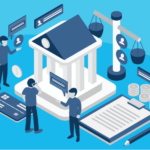Small loans are one of the most important tools for financial inclusion, but slow disbursals, manual underwriting, and high operating costs keep many underserved borrowers out. In that case, AI-driven micro loan software comes that provides automated credit decisioning, using alternative data for scoring, and also enables the real-time disbursal at scale. Because of this, lenders can easily approve more applications with the control of risk, decrease turnaround times, and lower per-loan servicing costs. This shift comes because the micro-lending market is growing rapidly, and it also determines the benefit from the growth because technology is the main catalyst. Here, we provide you with the information about how AI-Driven Micro-Loan Software is Revolutionizing Small-Scale Lending.
What AI Brings to Micro-Lending

Basically, AI enable the machine learning models to process transactional, telco and behavioural data to provide credit scores, detect fraud, and trigger the automated disbursal pipelines. They also provide digital KYC that streamlines onboarding, and monitor the models that give early warning signals for delinquency. If you compare with manual workflows, then AI-driven Micro Loan Software solutions deliver faster decisions and more scalable operations that save the time of lenders to serve many more micro-borrowers without proportionally increasing staff or cost.
Key comparative benefits: Traditional vs AI-driven microloan software
- Decision speed: Manual underwriting → days; AI automation → minutes to hours. McKinsey finds AI automation can reduce loan processing times by 20–60% and cut operating costs significantly.
- Inclusion: Traditional credit scoring excludes thin-file customers; AI uses alternative data so approvals can rise while keeping risk in check — studies show wider adoption of alternative data across lenders.
- Fraud & risk: AI systems flag anomalies and reduce fraud losses; case studies report 30–40% reductions in fraud losses with AI tooling.
“AI-enabled models are allowing lenders to underwrite borrowers who were previously invisible to banks, while improving loss prediction and operational efficiency.” — industry synthesis of recent studies.
Key Facts
- According to some studies, the global micro lending market is valued at over USD 100 billion in 2024 and, in the forecast, is expected to grow substantially through the next decade.
- 43% of lenders reported using alternative data to augment credit decisions in recent industry studies (helping thin-file borrowers). World Bank
- AI implementations have delivered 20–60% faster processing and meaningful cost reductions in lending operations, per McKinsey summaries.
- Reported reductions in fraud losses after deploying AI tools can reach 30–40% in some banking case studies.
- In India, microfinance remains large and fast-growing: millions of active borrowers and sizeable loan portfolios underline the real demand for scaled digital solutions.
Legacy Microloan System vs AI-driven Microloan Software
| Feature | Legacy Microloan Process | AI-Driven Microloan Software |
|
Average decision time |
Days | Minutes–hours. 20–60% reduction reported. |
|
Data used for scoring |
Credit bureaus, basic docs |
Credit bureaus + alternative data (telco, bill payments, transaction patterns) |
|
Fraud detection |
Rule-based, manual |
ML models detect complex patterns — fraud losses reduced 30–40% in cases |
|
Operational cost per loan |
High |
Lower (automation + scale) — improved margins. |
|
Financial inclusion impact |
Limited |
Expanded access for thin-file borrowers |
| Scalability | People-bound |
Highly scalable, cloud native |
Real-world impacts and examples
Digital transformation in microfinance has produced measurable results: regions that adopted digital disbursal and alternative scoring saw faster outreach and higher disbursal volumes. In India, microfinance portfolios and active borrower counts illustrate both demand and the opportunity for digital/AI tools to further boost inclusion — especially among women and micro-entrepreneurs.
Risks and Guardrails
AI is powerful for lending but not risk-free. Key concerns contain model explainability, data privacy and regulatory compliance. AI techniques only give decisions that can be justified to regulators and customers, and because of this, emerging research and development communities are addressing the issues, while practitioners adapt moral checklists and privacy by design.
How Lenders Should Approach Adoption
Here we provide you with step-by-step how the lender should approach adoption:
- If you start any process, then start with one product line or one region.
- Integrate with all alternative data sources, but make sure you validate fairness and predictive value.
- Deploy explainer tools and human-in-the-loop checks for any edge cases.
- Measure the standard outcomes like approval rates, default rates, time-to-disbursal, and fraud incidence and repeat it.
Conclusion
AI-assisted microloan software doesn’t have to be something we would use in a distant future — today, it is a practical tool that already helps with financial inclusion, reduces costs, and increases risk management in micro-lending parts ecosystems. The union of alternative data, machine learning and cloud-based distribution is changing very fast the scenario of who is getting credit and how soon. The ‘Responsible AI’ lenders alongside the ‘Product’ pilots will gain the strongest position. For those enterprises that plan to either construct or upgrade micro-lending systems, they should team up with technology providers that have a clear grasp of both AI and the regulatory, societal aspects of micro-lending. Jaguar Software India is a company that helps build compliant and scalable lending platforms; think of them as a tech partner to speed up your AI micro-loan journey.
FAQs
If I run a small lending business, how can AI help me?
AI simply cuts down your processing time and reduces the team workload. In that case, you will be able ot approve loans faster, minimize human errors, and also reach borrowers who don’t have traditional credit scores. Basically, it’s like having an intelligent assistant that never sleeps.
Can AI really make lending safer?
Yes, of course. AI simply track the data points from spending patterns to repayment history and detects the suspicious activity and clears them out. So, if you worry about fraud or bad loans, AI tools give you better protection and a deep understanding.
I’ve heard AI can be biased. Should I be concerned?
If AI is not properly trained, then it might reflect bias in the data it learned from. That is why it is very important to work with those software providers who use transparent, explainable AI models and regularly audit them.
How does AI speed up the loan approval process?
AI scans digital documents, verifies identity through e-KYC, and predicts repayment ability within minutes. So you apply loan online, then you see the approval done on the same day.









